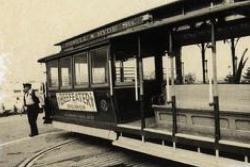cable cars
Cable cars are a traditional mode of daily transportation for San Franciscans, and an eagerly sought adventure for every visitor. Since 1964, the cable car has been designated by the National Park Service as a “national landmark.”
 The inventor of the cable car was Andrew Hallidie, a Scottish engineer and wire rope manufacturer. The inspiration for it is said to have come from an incident observed by Hallidie in 1869. He reportedly came upon a team of four horses struggling to haul a public conveyance up a steep San Francisco street. One horse slipped on the fog-slick cobblestones, causing the car to roll backward dragging all four horses with it. He promised himself he would put an end to this unintentional cruelty to animals.
The inventor of the cable car was Andrew Hallidie, a Scottish engineer and wire rope manufacturer. The inspiration for it is said to have come from an incident observed by Hallidie in 1869. He reportedly came upon a team of four horses struggling to haul a public conveyance up a steep San Francisco street. One horse slipped on the fog-slick cobblestones, causing the car to roll backward dragging all four horses with it. He promised himself he would put an end to this unintentional cruelty to animals.
As an engineer, it did not take Hallidie long to design the cable railway, by which an engaged cable in a slot would carry a car uphill or down at the same speed. Financing the project was more difficult, but faith and confidence prevailed, and construction began in May, 1872. Many labeled it “Hallidie’s Folly.” Laboring against a franchise deadline granted by skeptical city fathers, Hallidie and his crew worked through the night on the final day of grace. On August 2, 1873 at 5 a.m., Hallidie took the grip man’s position in the original cable car and triumphantly made the first run from the top of Nob Hill, safely down steep Clay Street to the wonderment of the doubting spectators.
Today, the cable cars still run from Hallidie Plaza at Market Street, up Powell Street, past the hotels on Nob Hill and down to Fisherman’s Wharf, providing the scenic ride which is the preferred mode of transportation for most of the millions of people who visit Fisherman’s Wharf annually






